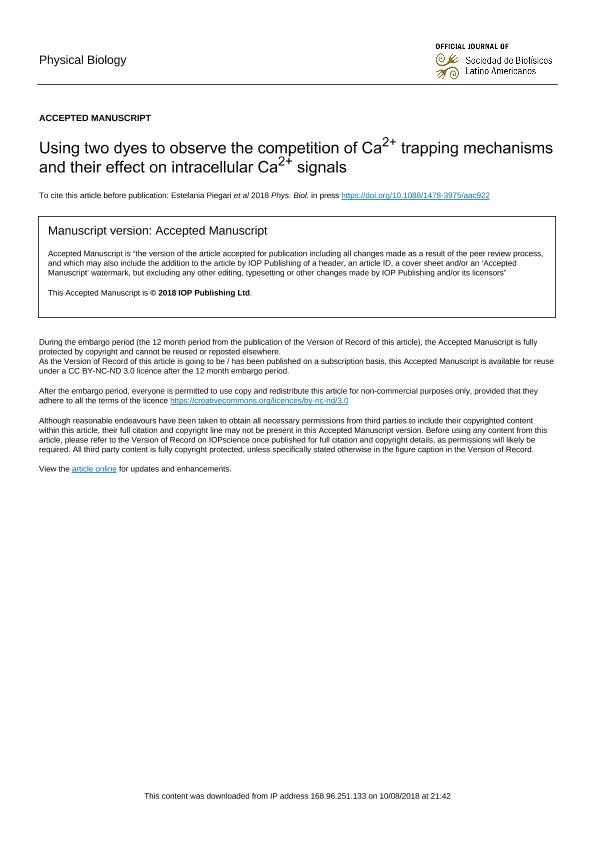Mostrar el registro sencillo del ítem
dc.contributor.author
Piegari, Estefanía

dc.contributor.author
Lopez, Lucía Fernanda

dc.contributor.author
Ponce Dawson, Silvina Martha

dc.date.available
2019-11-25T21:15:05Z
dc.date.issued
2018-08
dc.identifier.citation
Piegari, Estefanía; Lopez, Lucía Fernanda; Ponce Dawson, Silvina Martha; Using two dyes to observe the competition of Ca2+ trapping mechanisms and their effect on intracellular Ca2+ signals; IOP Publishing; Physical Biology; 15; 6; 8-2018; 1-16; 066006
dc.identifier.issn
1478-3967
dc.identifier.uri
http://hdl.handle.net/11336/90064
dc.description.abstract
The specificity and universality of intracellular Ca2+ signals rely on the variety of spatio-temporal patterns that the Ca2+ concentration can display. Ca2+ liberation through inositol 1,4,5-trisphosphate receptors (IP3Rs) is key for this variety. In this paper, we study how the competition between buffers of different kinetics affects Ca2+ signals that involve Ca2+ release through IP3Rs. The study also provides insight into the underlying spatial distribution of the channels that participate in the signals. Previous works on the effects of Ca2+ buffers have drawn conclusions 'indirectly' by observing the Ca2+-bound dye distributions in the presence of varying concentrations of exogenous buffers and using simulations to interpret the results. In this paper, we make visible the invisible by observing the signals simultaneously with two dyes, Rhod-2 and Fluo-4, each of which plays the role of a slow or fast Ca2+ buffer, respectively. Our observations obtained for different concentrations of Fluo-4 highlight the dual role that fast buffers exert on the dynamics, either reducing the intracluster channel coupling or preventing channel inhibition and allowing the occurrence of relatively long cycles of Ca2+ release. Our experiments also show that signals with relatively high Ca2+ release rates remain localized in the presence of large Rhod-2 concentrations, while the mean speed of the elicited waves increases. We interpret this as a consequence of the more effective uncoupling between IP3R clusters as the slow dye concentration increases. Combining the analysis of the experiments with numerical simulations, we also conclude that Ca2+ release not only occurs within the close vicinity of the centers of the clearly identifiable release sites (IP3R clusters) but there are also functional IP3Rs in between them.
dc.format
application/pdf
dc.language.iso
eng
dc.publisher
IOP Publishing
dc.rights
info:eu-repo/semantics/openAccess
dc.rights.uri
https://creativecommons.org/licenses/by-nc-sa/2.5/ar/
dc.subject
CALCIUM BUFFERS
dc.subject
CALCIUM PUFFS
dc.subject
SPATIO-TEMPORAL DISTRIBUTIONS
dc.subject.classification
Otras Ciencias Físicas

dc.subject.classification
Ciencias Físicas

dc.subject.classification
CIENCIAS NATURALES Y EXACTAS

dc.title
Using two dyes to observe the competition of Ca2+ trapping mechanisms and their effect on intracellular Ca2+ signals
dc.type
info:eu-repo/semantics/article
dc.type
info:ar-repo/semantics/artículo
dc.type
info:eu-repo/semantics/publishedVersion
dc.date.updated
2019-10-21T13:34:28Z
dc.journal.volume
15
dc.journal.number
6
dc.journal.pagination
1-16; 066006
dc.journal.pais
Reino Unido

dc.journal.ciudad
Londres
dc.description.fil
Fil: Piegari, Estefanía. Consejo Nacional de Investigaciones Científicas y Técnicas. Oficina de Coordinación Administrativa Ciudad Universitaria. Instituto de Física de Buenos Aires. Universidad de Buenos Aires. Facultad de Ciencias Exactas y Naturales. Instituto de Física de Buenos Aires; Argentina
dc.description.fil
Fil: Lopez, Lucía Fernanda. Consejo Nacional de Investigaciones Científicas y Técnicas. Oficina de Coordinación Administrativa Ciudad Universitaria. Instituto de Física de Buenos Aires. Universidad de Buenos Aires. Facultad de Ciencias Exactas y Naturales. Instituto de Física de Buenos Aires; Argentina
dc.description.fil
Fil: Ponce Dawson, Silvina Martha. Consejo Nacional de Investigaciones Científicas y Técnicas. Oficina de Coordinación Administrativa Ciudad Universitaria. Instituto de Física de Buenos Aires. Universidad de Buenos Aires. Facultad de Ciencias Exactas y Naturales. Instituto de Física de Buenos Aires; Argentina
dc.journal.title
Physical Biology
dc.relation.alternativeid
info:eu-repo/semantics/altIdentifier/url/http://iopscience.iop.org/article/10.1088/1478-3975/aac922
dc.relation.alternativeid
info:eu-repo/semantics/altIdentifier/doi/http://dx.doi.org/10.1088/1478-3975/aac922
Archivos asociados
